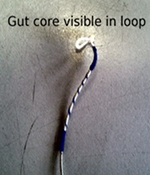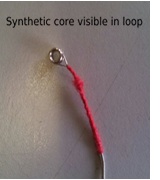Master Hand Violin Shop
Store Hours
Owner
Elizabeth Ecklund
Elizabeth Ecklund
In part 1 of our String Theory series, we discussed changing strings. But what if you don't even know which strings to purchase to change? You hear "Larsens!" "Titanium wrapped C strings!" "Perlon cores!" "Infeld Red and Infeld Blue!" "Oliv, Eudoxa, and Golden Labels!", and you feel like calling, "uncle". We sympathize, since we have to stock all these strings. But we also recommend you don't give up quite yet! In part 2 of our String Theory series, we are going to make sense of the different types of strings on the market. While there are many brands of strings, at their core, there are really only three types of strings: gut, steel, and synthetic core strings.
When violin playing evolved in the baroque era,
choosing a string was easy;  your choice was gut (sheep gut, not cat
gut), with the G string sometimes wrapped in silver
for increased volume. These strings had a lovely, mellow tone, but
unfortunately they also had some longevity issues owing
to their sensitivity to temperature, humidity, and, well, air.
They also did not project particularly well and went
out of tune very quickly. However, the beauty of gut
has made up for the myriad of shortcomings, and gut strings are still used
today. They are now all metal-wrapped with a gut core, and the E
string is no longer made of gut. Many people
consider these to be the gold-standard for strings.
your choice was gut (sheep gut, not cat
gut), with the G string sometimes wrapped in silver
for increased volume. These strings had a lovely, mellow tone, but
unfortunately they also had some longevity issues owing
to their sensitivity to temperature, humidity, and, well, air.
They also did not project particularly well and went
out of tune very quickly. However, the beauty of gut
has made up for the myriad of shortcomings, and gut strings are still used
today. They are now all metal-wrapped with a gut core, and the E
string is no longer made of gut. Many people
consider these to be the gold-standard for strings.
Around the turn of the 20th century,  string buying got a little more complicated as steel core
E-strings became popular. Steel strings increased
volume and decreased the need for constant
tuning compared to gut strings.
This obvious advantage quickly led to the
development of steel core
strings for all strings. The problem of projection and longevity
was solved! Unfortunately, steel strings provided
neither the sweetness nor the beauty of gut strings.
Still, steel core strings became and remain a staple of
beginning students who are not comfortable with
tuning, as well as those lacking
the desire to invest time, effort, and money in gut strings.
string buying got a little more complicated as steel core
E-strings became popular. Steel strings increased
volume and decreased the need for constant
tuning compared to gut strings.
This obvious advantage quickly led to the
development of steel core
strings for all strings. The problem of projection and longevity
was solved! Unfortunately, steel strings provided
neither the sweetness nor the beauty of gut strings.
Still, steel core strings became and remain a staple of
beginning students who are not comfortable with
tuning, as well as those lacking
the desire to invest time, effort, and money in gut strings.
For many years, it appeared that it'd be gut or
steel core forever.  However, in the 1970's, Tomastik
Infeld added a third string to the mix when they developed a perlon core
string. Called Dominant, this string revolutionized the
string industry. Dominant strings have an increased
sweetness and beauty over steel strings and yet are
not sensitive to the environment like gut
strings. Unfortunately, they are still more difficult to tune than
steel strings and have a shorter life span. Still, Dominant strings have also led to the
development of many different synthetic core strings,
which make up the majority of the strings currently
on the market. Many of the synthetic strings are
very nice and may someday soon be able replace gut
entirely.
However, in the 1970's, Tomastik
Infeld added a third string to the mix when they developed a perlon core
string. Called Dominant, this string revolutionized the
string industry. Dominant strings have an increased
sweetness and beauty over steel strings and yet are
not sensitive to the environment like gut
strings. Unfortunately, they are still more difficult to tune than
steel strings and have a shorter life span. Still, Dominant strings have also led to the
development of many different synthetic core strings,
which make up the majority of the strings currently
on the market. Many of the synthetic strings are
very nice and may someday soon be able replace gut
entirely.
Which string core is the best for you? As a rough guideline, steel core is typically prefered by beginners, fiddlers, and casual players. Synthetic core is prefered by advancing students, serious players, and some professionals with instruments that thrive with synthetic. Gut is prefered by serious students and professionals with instruments that thrive on gut. Of course, it's always best to check with your private teacher if you have one. And you may want to try a couple different string cores to find which works best with your instrument.
Share on Facebook